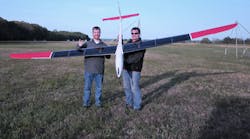Unmanned Aerial Vehicles (UAVs) may soon be flying away into the sunset powered by that very same sunlight. Researchers at the U.S. Naval Research Laboratory (NRL), Vehicle Research Section and Photovoltaic Section are building on the concepts of autonomous UAVs. Their goal is to design photovoltaic cells into UAVs with electric-powered propulsion systems for capturing electric energy from the sun for longer flight times.
One goal of the Solar Photovoltaic and Autonomous Soaring Base program and the U.S. Marine Corps’ Expeditionary Energy Office (E2O) is to achieve full 24-hour/day information, surveillance, and reconnaissance (ISR) capabilities with UAVs. The NRL researchers are pursuing the worth of combining autonomous soaring algorithms and photovoltaic cells to extend UAV flight time. The use of solar energy may not only extend the possible travel distance of an UAV, but also decrease the amount and weight of the batteries that a warfighter would be required to carry into the field.
Thus far, the experimental UAV has achieved flight times exceeding 10 hours. A custom photovoltaic array is integrated into the center wing panel of an PV-SBXC aircraft as a drop-in replacement for the original wing. A power management and distribution system converts the power from the solar arrays to direct current (DC) voltage, which can be used to recharge the on-board batteries and/or power the electric drive motors for propulsion.
The solar-powered flight time can be boosted by the use of an autonomous soaring software algorithm. It can, for example, monitor winds around the aircraft that may help keep it in flight, and guide the UAV to stay in available updrafts for longer flight times. The algorithm was disabled when the UAV’s flight time was evaluated by the addition of the solar-power energy.

